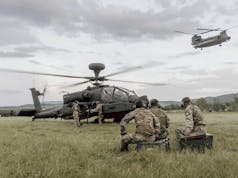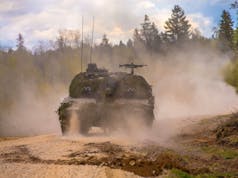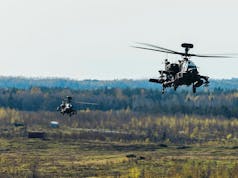DE&S have awarded a £46 million contract to extend the British Army’s use of its Mobile Artillery Monitoring Battlefield Asset (MAMBA) weapon-locating radar systems.
The contract secures the continued use of the life-saving critical operational counter-fire capability that has been in service since 2003, supporting operations in both Iraq and Afghanistan. According to DE&S, the contract will see the company work with the Royal Artillery’s 5th regiment based in Catterick, to ensure the capability remains in service until 2026.
Team leader Colonel Jeremy Sharpe, said:
“Providing the best possible equipment to our troops is what we do best, and I am delighted that we have now secured the future of MAMBA for the next six years.”
The MAMBA system works by giving advanced warning signals to troops on the front line by detecting incoming hostile fire. It is a highly-mobile weapon locating system, used for tasks including counter-battery missions and fire control, tactically deployed close to the forward line of troops.
Based on the calculations produced by MAMBA, priorities are made and directions are provided for effective counterbattery fire. In fire control mode, MAMBA will track the projectiles of own fire and extrapolate the points of impact. In sense and warn mode, extrapolation of points of impact of incoming fire will trigger a timely warning to its own troops.
Deliveries of the MAMBA mid-life extension will take place between 2022 and 2023, with the support contract covering 2020 to 2026.













Works even better when linked to a phalanx system.
Very impressive!
https://www.youtube.com/watch?v=3UVuV5WvraQ
From what i heard they weren’t that effective in practice and the biggest problem is that when they were used, they were taken off a ship, which means in a real war situation, we would not have enough units to go around.
At $5.6M we could afford to purchase some if required no doubt.
https://kinghellkiller.tumblr.com/post/41621845225
In Iraq the Yanks had four guarding the Airbase I was on. There were daily rocket and mortar attacks, so the Phalanx was being used constantly. I don’t know where you got your information, but very few if any attacks made it past them. They also had Paladin and 120mm mortars for counter-battery response, so no messing around. Mind you Predators we’re only being used for recon and overwatch, before the much larger Predator/Reapers were brought that had Hellfires.
Not sure if the Phalanx was using the depleted uranium rounds, but it was like fireworks night when they destroyed a target. The main benefit though was physiological, knowing that when when you put your head down, there was something protecting you. It’s all very good having a radar system detecting incoming and then activating an alarm. It doesn’t prevent incoming from reaching its target!
I was in Iraq working with the Phalanx & Mamba guys. It generally worked nicely.
We didn’t use DU rounds at all. It was some HE/trace/self destructing fancy round that was very expensive to procure.
It should be noted that knowing where it’s coming in and when means you can direct the response. Rather than having to alert the entire base and then wait for the calls to come in as to where it landed, you can send the response teams out straight away, before it even lands.
Amen, brother.
Good news…
However, we need some artillery to shoot back ;P
No mention of who the contract was with?
Probably with the manufacturer, Saab.
Might be wrong, but just checked, 5 Regiment RA have 4 systems.
How does one spread something so thin already over our deployable Division of 3 Brigades?
It might be Ok as part of Base ISTAR but we keep reading we have moved on from that.
There should be a battery per Brigade. 5 RA does have 3 batteries ( plus 2 more, one for 16AA and Sphinx ) but that’s in effect 1 Mamba per battery! What if it breaks, or is damaged by hostile fire?
The BV carrier is not ideal for Strike either!!
Seems to me to be a capability that is almost meaningless. Especially when you add the fact, that other commentators have, that there are so few pieces of artillery to fire back!!
On Phalanx, didn’t we have a system guarding one of the brit bases? Was it American, or one of ours? If ours, what happened to it?
When they are returned they are refurbished by Babcock and go back into the pool. So most of the units which were in Afghanistan are probably on ships now.
I believe that 6 Phalanx were converted for land basing. 2 were converted back to original naval spec under a contract placed in 2014, and 4 under a contract placed in 2015.
I mean the MAMBA radar Mark, not CIWS.
Mark, ignore my last, I’m forgetting I even asked about Phalanx!
Thanks for the answer.
Hang on, 3?! When did that happen?!
When I was there (about 10 years ago, admittedly) with the reme workshop, I can remember seeing at least 6 around the camp, plus those deployed.
Spot on Daniele. Another example of a good bit of kit, bought to say we have the capability, not to enable its proper use.
MAMBA is not the only system we have to defend against artillery. It is the only radar we have to direct counter battery fire. I believe it was employed alongside systems maybe such as exactor and 105mm as well ground forces to locate and destroy the mortar systems.
Giraffe AMB was deployed in Afghan and provided warning with sense and warn.
UK also has an acoustic based system called HALO for locating artillery and there’s potentially other systems in use.
I would assume as the old seawolf system could intercept artillery rounds that CAMM would also be capable of doing the same. Phalanx is very capable, but short ranged probably more relevant in asymmetric warfare where combatants use civilian clothing vehicles to get close to bases. Afghan & Iraq are both asymmetric theatres and we were against a relatively unsophisticated enemy, but both have caused challenges, this has therefore reinforced the fight dispersed doctrine.
This contract is until 2026 I’m not sure how many MAMBA are in service but Next Generation Weapon locating system project previously called SERPENS is due to replace it, therefore it maybe possible that if required more of these systems would be procured.
It would be unlikely anymore MAMBAS bought if it is at end of its service life. For hard kill options long-term hopefully Dragonfire will be purchased and available in a land version which will hopefully give even better protection.
We seriously do need to invest in this type of technology as well as GBAD in general. I personally think SAMP-T is a requirement for the uk, but we seem reluctant to even invest in CAMM ER.
But as people have commented were struggling to field enough artillery as it is to be able to effectively fire back. The forth coming review will have to address these issues and not simply be another cutting exercise. To claim we have full spectrum capability is a falsehood we’ve only just got maritime surveillance and carrier air power back which shouldn’t be luxury items for the UK.
Seems like a good capability, is there any overlap with the radar type and the Giraffe system we’re using with Land Ceptor for AAD? It’d be nice to be able to buy, deploy, train for and maintain one larger pool of radars, which can then provide some overlap in the field too (even if they can’t do the two things at the same time).
As has been noted below though, it’s not a whole lotof help without NLOS counter-battery options. I’ve said it before and I’ll say it again, 120 mm mortars on a Boxer is the way to go. I’ll take a 155 mm howitzer on wheels too, but I know the budget it thin to the point of threadbare. With the mobile mortar system, at least we’re giving Strike some survivability while also protecting bases. Same rule of reducing different types of weapon system for training, maintenance, bulk ordering etc.
if anyone’s interested, UK Land Power had a good guest article on artillery in general. I hav to say, I agree with it. We can’t justify tracked heavy armour as much as we need to justify more mobile armoured units and indirect fires.
https://uklandpower.com/2020/04/21/tanks-or-indirect-fires-if-we-cant-afford-both-which-should-we-choose/
Both MAMBA which is known as ARTHUR as well as the Giraffe AMB which is what we are using for land ceptor/sky sabre are both SAAB products. So I wouldn’t be surprised if they could talk to one another. What would be a potential good purchase would be Giraffe 4A which combines all capabilities of ARTHUR & Giraffe AMB I believe Thales ground master 200 has similar capabilities. I know I saw an article that the British Army is investing in BISA which hopefully will help with data sharing.
I’ve seen the Land Power article and I disagree in that I believe funding needs to be found to do both. Strike has its strengths but also its weaknesses sending a Strike brigade to form support for a dogged defence of Europe in a large scale attack is not its strengths and is not something helpful to our allies in this scenario.
Strike can respond quickly to the next Ukraine type crisis that will hopefully stop the other scenario. But if the worst happens then NATO needs every MBT it can get its hands on and I think we’d effectively shirk our responsibilities with just strike and indirect fire.
However, having said that if we had to, absolutely had to choose the heavies could go in to storage/reserve but proper plans should be made to reactivate & rapidly upgrade. Obviously things such as 120mm rifled in CH2 would have to stay.
I think if the next defence review is honest and looks at all the issues then it should provide extra funding. I personally think we should be matching the US on %GDP. In reality if we’re lucky some extra temporary funding may come & % may go to 2.5. If it goes like other SDRs the UK will fall in to strategic and international irrelevance.
As a result like it or not if that happens I believe the country will suffer as a whole as we won’t be able to offer any allies or trading partners meaningful support. They will make the best deals with those that can.
I agree we definitely need both Heavy and Strike brigades that can operate separately, but can also complement each other. The fixation with Russia may be justified, but the belief that Russia will use the same tactics they developed during he Cold War is blatantly wrong and stupid.
Having looked at Russia’s latest acquisitions, you’ll see it is multi-faceted. They have continued with the Heavy strike thesis, especially with the designs of the T14 and T15. But they are also developing the lighter high mobility Strike concept with the Bumerang (think I’ve spelt that right). The the amphibious and airborne delivery concepts using the BMD4 series, the 2S25 Sprut-SD tank destroyer and the 2S31 Vena gun/mortar mounted on the BMP3 chassis shows that they are still looking at outflanking and operations beyond the forward line of contact.
The Bumerang is an interesting vehicle as it follows the Stryker layout instead of the older BTR series with a rear door instead of side doors. The vehicle comes in a number of flavours with fire support, artillery and air defence versions coming out soon.
For us we should have a clear demarcation between tracked and wheeled. With the wheeled element being the Strike brigade. The Strike element must be centre on the Boxer using the chassis for the support elements. The modular system is ok, but we require dedicated elements within the brigade that can keep up and pull their weight. Fitting the new Warrior turret or Ajax turret will give a substantial fire power boost. But we still need a more powerful weapon system fitted for fire support, perhaps the turret from the Mjölner CV90 armed with an auto-loading 120 mm mortar is the answer and a anti-tank version armed with Brimestone. It’s all doable, we just need the will and funds to put it in place.
I agree about the mobile mortar system on a Boxer, do we even have that capability anymore? We used to have mortars on the old 432’s but that was a long time ago and I don’t think we currently have anything like it in service.
The thing with British defence planners is that they tend to be reactive which is the wrong way to do things in my opinion. The Chally 2 is another example… We didn’t use them after major operations in Iraq or at all in Aghan so as a result of this, they’ve binned half the number of MBT’s we have. Now, with the threat from peer adversaries coming into focus, they’re realising it was a mistake so the M.O.D are now looking to upgrade them. It was that bad that they reassigned traditional armoured units to using vehicles like the MRAP…..the decision makers and shakers in Whitehall are a disaster for our fantastic Armed Forces.
I’m no expert on the Army’s gear, Daniele, Gunbuster or Rudeboy would be your people for that. But I believe that we don’t have a mobile mortar system in operation, and no mortar larger than the 81 mm at all.
I would generally agree with you, but unfortunately I think that the Army has to shoulder some of the blame for that; the government may set strategic objectives as part of SDSRs and suchlike (informed by advice from all over, including the armed forces), but it’s the branches themselves who decide how they’re going to deliver the “service” expected from them to achieve the overall goal. It is the Army that has deferred CR2LEP, and indirect fires have been reduced to such a small capability compared to allies and potential opponents alike (admittedly as much due to budget than desire). It seems to me that the amry have felt obliged by budget and government ambition to attempt to maintain a marginal capability in everything (CR2 is not longer competitive with the best in NATO, FIRES is almost non-existent, SHORAD is in a similar way, others more knowledgable than I could go on), rather than be brutal but have proper capabilities that join up and that we can really use.
What happened to the previous, larger, COBRA system which was meant to have a much greater range to cue systems like MLRS/GMLRS. Ours disappeared from service around the time some appeared in the inventory of the Turkish Army, which was not a launch customer. It seems we have sacrificed range for deployability and now face a return to the potential of conventional warfare where the longer ranged system would come into its own.